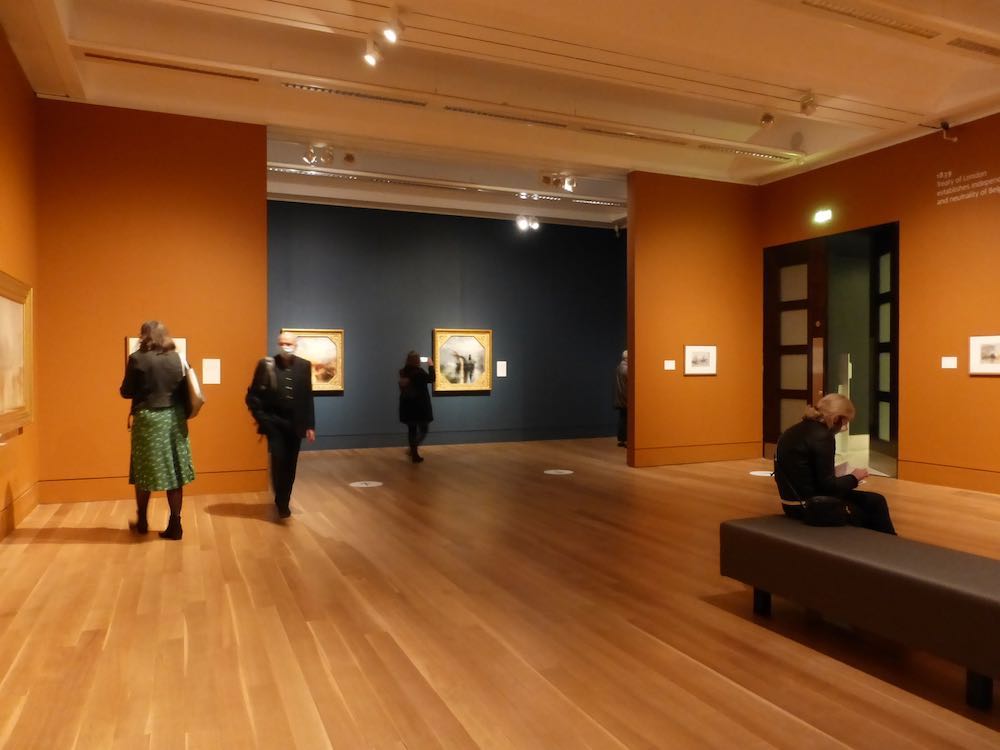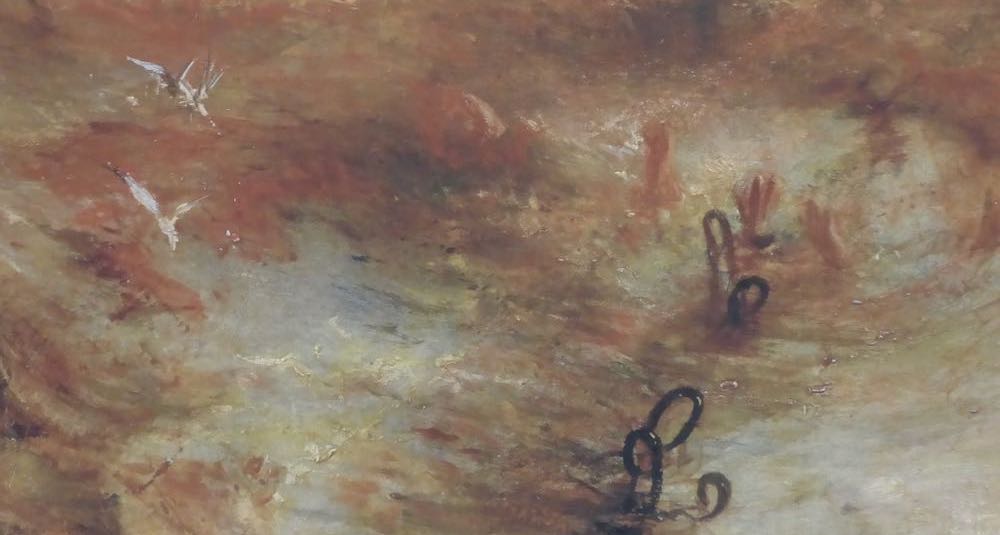The photographs below were taken by the author at the press view of the exhibition, or come from images already on this site [Click on all the images to enlarge them, and for more information about them.]


At the press view. Left: Visitors stop to discuss and admire The Fighting Temeraire. Right: On the far wall hang the pair, War. The Exile and the Rock Limpet, and Peace — Burial at Sea.
Tate Britain's new exhibition could not be more timely. Coming face to face with Turner on canvas is always exhilarating. An artist ahead of his age, he chose, mixed and applied colour with panache, and was equally daring in composition. All this is well known. But the curators show him to have been no less radical in the way he engaged with his age. The greatest impact here comes from the most disturbing paintings, those that explore suffering and death in his own times. Those will always be relevant. Other paintings, however, convey the excitement of recent events, and industrial and technological developments. These give us something more encouraging — some reassurance about continuity, and human ingenuity and thirst for improvement.


Left: The Battle of Trafalgar, as Seen from the Mizen Starboard Shrouds of the Victory. Right: The Field of Waterloo.
The fiery, apocalyptic canvases draw the eye first, but when we look more closely, the details are just as memorable. Here, in his Battle of Trafalgar (1806-8), is the figure of Nelson being laid on the deck of HMS Victory, picked out by his white uniform, yet tiny, in his forlorn group of comrades, beneath the towering masts and sails and billowing smoke of battle at sea. And here, in Waterloo (exhibited 1818) is the field untidily strewn with the dead, the British singled out by their uniforms, but otherwise mingled with their foes like their blood on the earth. No less aware than the Pre-Raphaelites of the transfixing power of such minutiae, Turner went to great lengths to research and study each episode he depicted; he went up close to it, validating even the most apocalyptic vision with identifiable detail.

Slave Ship: Slavers Overthrowing the Dead and Dying — Typho[o]n Coming On.
At the current time, Slave Ship strikes a particular chord. A later work, first exhibited in 1840, it could only be represented in the exhibition by a reproduction. But the fact that it needed to be shown, even in this form, is a tribute to its importance. It is Turner's protest painting, the one in which he documents the practice of the most corrupt captains of slave ships, who threw unsaleable human cargo overboard so that they could claim compensation. The artist lets us glimpse the slaves' shackles among the drowning men and indistinct flotsam in a roiling sea; the sense of outrage is palpable. The chains cry out against the heartlessness of all who viewed their brother-men as commodities, and dispensable ones at that. For the unfortunate victims, the only freedom comes with death. In another twist to this wretched tale, the omens for the ship itself are bad. The full title of the painting suggests that the captain and crew can expect swift retribution. If we had a statue of Turner now, we would not need to discuss its removal. We could be proud of it.

The Disembarkation of Louis-Philippe at the Royal Clarence Yard, Gosport, 8 October 1844 (unfinished sketch in oils).
While Turner refused to flinch from the worst in human nature, his quieter paintings are no less relevant today. Some are topographical in nature, or reflect social history, showing life as it was then, life as it was evolving into an age more like our own. He painted Schloss Rosenau, for example, the castle in Germany where Prince Albert was born; and (unwittingly) the penultimate chapter of the French Revolution: an oil sketch of the arrival of Louis Philippe of France in 1844, in a blaze (or haze) of glory. A few years later, Louis Philippe would arrive again, ignominiously incognito, to spend his last years in exile in Surrey.


Left: The Chain Pier, Brighton. Right: Rain, Speed, Steam.
Turner's modern world was also a world of canals, furnaces, and other signs of the industrial revolution. If we compare Turner's depiction of the new Chain Pier in Brighton (painted in about 1828) with Constable's of just a few years earlier, we see how innovative he was. Constable's pier comes back to the shore, where the fishermen are at their nets and life goes on as it always has done. But Turner's pier extends to the sea, to the route to and from France (a crossing he made himself), to the world beyond, to the future. Here as in his well-known Rain, Speed, Steam, where the train thrusts through the elements and seems part of them itself, the topical references in Turner's work are as subtle and powerful as his painterly effects.

A nineteenth-century model of the Firefly, the train depicted in Rain, Speed, Steam. In the background is Lifeboat and Manby Apparatus Going off to a Stranded Vessel Making the Signal (Blue Lights) of Distress, c.1831.
One of the most interesting rooms here shows Turner's connections with his literary contemporaries: he illustrated works by Sir Walter Scott and Byron, among others, as well as writing verses himself. He emerges now in a more rounded way, as a man who saw what was important in his world, and responded to it with humanity. His topical references place him in his own age, but, in the way he treated them, he transcends it. Modern in his own times, he strikes us as modern even now.
Related Material
Created 30 October 2020